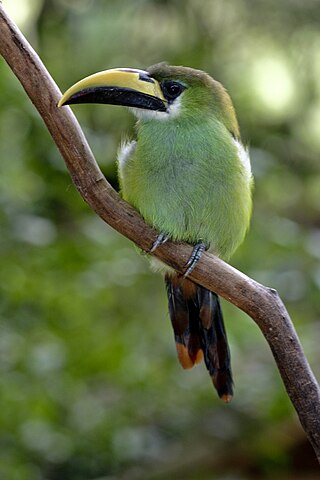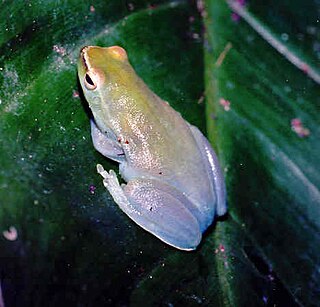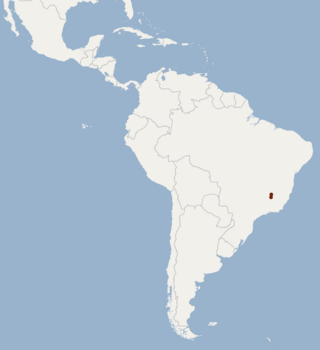
The emerald toucanet is a species of near-passerine bird in the toucan family Ramphastidae. It is found from Mexico to Nicaragua.

Sphaenorhynchus is a genus of frogs in the family Hylidae. They are also known as lime treefrogs or hatchet-faced treefrogs. They are found in the Amazon and Orinoco River basins of South America, the Guianas, Trinidad, and southern and eastern Brazil. The majority of the species are associated with the Atlantic Forest domain in Brazil.

Bokermann's nectar bat is a bat species from South America. It is endemic to Brazil. It feeds on nectar, and is listed as an endangered species.
Nymphargus prasinus is a species of frog in the family Centrolenidae, formerly placed in the genus Cochranella. It is endemic to Colombia. Its natural habitats are subtropical or tropical moist lowland forests, subtropical or tropical moist montane forests, and rivers. It is threatened by habitat loss.
Scarthyla goinorum, also known commonly as the Madre de Dios treefrog and the Tarauaca snouted treefrog, is a species of frog in the family Hylidae. The species is endemic to South America.
Sphaenorhynchus bromelicola, the Bahia lime treefrog, is a species of frog in the family Hylidae. It is endemic to eastern Brazil and only known from its type locality near Maracás, Bahia. It is similar to Sphaenorhynchus orophilus. It lives in terrestrial bromeliads on the forest edge and in open areas. The tadpoles develop in permanent pools. It is abundant at the type locality. Potential threats to this species include habitat loss caused by agriculture, wood plantations, logging, collection of bromeliads and human settlement, though data is insufficient to grant it conservation status.
Sphaenorhynchus carneus, the Napo lime treefrog, is a species of frog in the family Hylidae. It is found in the upper Amazon Basin in southern Colombia, Ecuador, Peru and in central Amazonia in Brazil. It might also occur in Bolivia.

Sphaenorhynchus lacteus, the Orinoco lime treefrog or greater hatchet-faced treefrog, is a species of frog in the family Hylidae. It is a widely distributed species found in the Orinoco and Amazon basins in Venezuela, the Guianas, Colombia, Brazil, Ecuador, Peru, and Bolivia. It also occurs in Trinidad and Tobago.
Sphaenorhynchus palustris, the Linhares lime treefrog, is a species of frog in the family Hylidae. It is endemic to eastern Brazil and known from its type locality, Linhares in Espírito Santo, and from Bahia north to Praia do Forte.

Sphaenorhynchus pauloalvini, or Paulo's lime treefrog, is a species of frog in the family Hylidae. It is endemic to eastern Brazil and is known from two locations in Bahia, Itabuna and Una.

Sphaenorhynchus planicola, the Rio lime treefrog, is a species of frog in the family Hylidae. It is endemic to southeastern Brazil and occurs in the southern Bahia, Espírito Santo, and Rio de Janeiro states at elevations below 100 m (330 ft) above sea level.
Sphaenorhynchus platycephalus, commonly known as the South American lime treefrog or Lutz's lime treefrog, is a species of frog in the family Hylidae. It is endemic to south-eastern Brazil where it occurs in the Serra do Mar and Serra da Mantiqueira ranges in the states of Rio de Janeiro, São Paulo, and Minas Gerais. However, Araujo-Vieira and colleagues suggests that the Serra da Mantiqueira population could represent Sphaenorhynchus canga; the two species are similar.
Crossodactylodes bokermanni is a species of frog in the family Leptodactylidae. It is endemic to Espírito Santo state of eastern Brazil. While its range is small, it is locally abundant. It is an arboreal species living in forests near 560 m (1,840 ft) altitude. It is associated with epiphytic bromeliads where its tadpoles develop. It is threatened by habitat loss.

Bahius is a genus of frog in the family Strabomantidae. It contains a single species, Bahius bilineatus, commonly called the Two-lined robber frog.

Pristimantis vinhai is a species of frog in the family Strabomantidae. It is endemic to Brazil. Its natural habitat is tropical moist lowland forests. It is threatened by habitat loss.
Hylodes mertensi is a species of frog in the family Hylodidae. It is endemic to Brazil. Its natural habitats are subtropical or tropical moist lowland forest and rivers. It is threatened by habitat loss.
Hylodes ornatus or the ornate tree toad is a species of frog in the family Hylodidae. It is endemic to Brazil. Scientists know it from the type locality, Parque Nacional do Itatiaia in the state of Rio de Janeiro. Its natural habitats are subtropical or tropical moist lowland forest, subtropical or tropical moist montane forest, and rivers. It is threatened by habitat loss.
Hylodes otavioi, Otavio's stream frog, or the Otavio tree toad is a species of frog in the family Hylodidae.
Physalaemus aguirrei is a species of frog in the family Leptodactylidae. It is endemic to eastern Brazil and occurs in the southern Bahia, northern Espírito Santo and northeastern Minas Gerais. The specific name aguirrei honours Alvaro Coutinho Aguirre, a Brazilian zoologist. However, common name Linhares dwarf frog has been proposed for it.








